Disclosure: Meeple Mountain received a free copy of this product in exchange for an honest, unbiased review. This review is not intended to be an endorsement.
When I first read about Redsky, I was excited. This seemed to be a game right up my alley. It also seemed like the kind of game my group would enjoy. Many of them (myself included) like games where we can build up our power and create engines of efficiency to propel us into the next stage of the game. Some games like this are made where it is easy to build; others make you work for it. Either way, it is generally a good time!
The theme sparked my imagination. The idea is that a group of iron-age civilizations are working to survive and define themselves over the ages while competing for resources. Meanwhile, some powerful alien race watches over them—you see, these factions are not on Earth (or even some other planet). They are on a giant spaceship unwittingly competing in an apocalyptic Hunger Games-like scenario where only one of these species will survive to be seeded on some world somewhere, before the next group of contestants compete for survival.
Basic Game Play
The setup for the game includes building the main board. This area of the game is where the cities, villages, armies, and resources live. The board is made up of hexagonal spaces that are a part of tiles that contain 2, 3, or 4 spaces. Each space has a terrain type that will have one or (rarely) two resources it generates. As the board is built, the tiles are placed upside down so you have no idea what resources are going to be where. The central part of the world is generated so as to have a specific number of available spaces (13 for a two player game, 22 for a three player game, or 28 for a four player game). The exact distribution of 2, 3, and 4-space tiles is determined by an 8-sided die roll. Once the central map is assembled, each player receives a 2 and a 3-space tile to create a peninsula for their home territory. Once all of the tiles are placed, they are then flipped over to reveal what sort of world they live upon.

The second area where the game takes place is called the element board. This board has six elements in three pairings that oppose one another. They are Water ↔ Fire, Earth ↔ Air, and Aether ↔ Void. Players start on the center space, not aligned to either side, in each of these pairings, except for one. Each of the factions has one pairing where it favors one side or the other by two points. Where a faction lands on these tracks is important thanks to Vice and Virtue cards. These cards, of which there are four in each element (two copies of each) are the mechanism by which the game defines how a faction has developed.
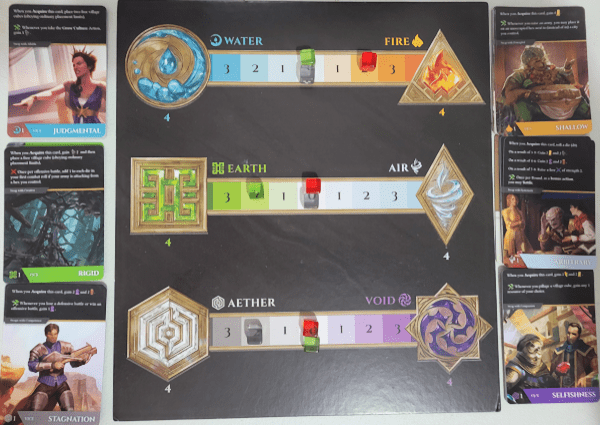
Each stack of cards has a Vice at levels 1 and 3, and a Virtue at levels 2 and 4. In order to acquire these cards, a faction needs to be at the appropriate level in that element. So, for example, if a faction wanted to claim the level 1 Aether Vice (Stagnation), they would need to first be on the Aether side of that track. Vices do not cost resources; Virtues do.
These cards are important not only for the abilities and bonuses they grant, but for the fact that they are the score at the end of the game. Players who still have at least one city on the board at the end of the game score one point for each Virtue they have, and lose one point for each Vice they have. This is the only source of points in the game.
The last area of the game is the Event Board. The game is played over eight rounds. Each round consists of four phases. Rounds 1 and 2 are called the Heroic Era; rounds 3 and 4 are the Classical Era; rounds 5 and 6 are the Exodus Era; and rounds 7 and 8 are when the aliens running this ship pull out all the stops, turn the sky red, and unleash the apocalypse: the Redsky Era. There are four possible events for each era; at the start of the game, two random cards from each era are randomly selected and placed into a pile, face down in era order (i.e., Heroic, Classical, Exodus, then Redsky). At the start of each round, a new event is revealed and the others are cycled. Each event can impact one or two rounds. When the last event has been revealed, you are in the final round of the game.
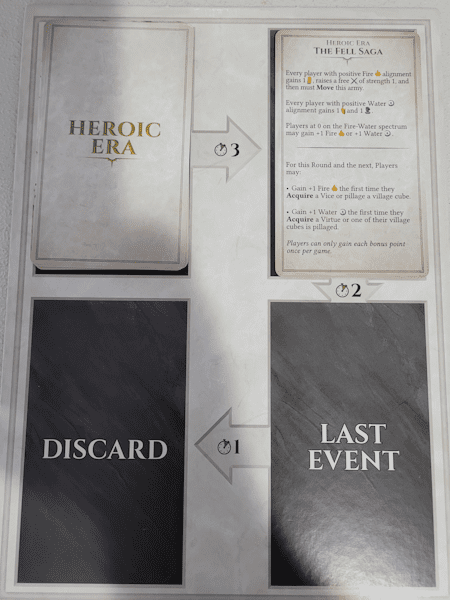
Once the main board is built, each player is randomly assigned a faction (which determines their player color). They receive their playing pieces (large and small cities, army dice, village cubes) as well as the starting resources for that faction. They place a small city on one of the outer spaces of their peninsula. Once this is complete, roll dice to see who the first player is and you are ready to begin.
Each round of the game consists of four phases.
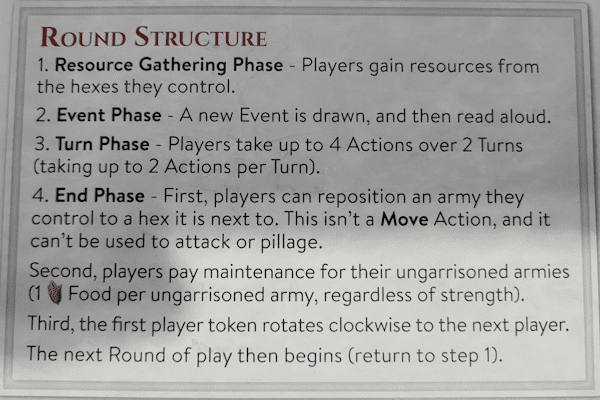
- At the start of each round (except round 1), players gather resources from the cities they control on the board. Each small city and village generates resource(s) on the space it occupies; each large city generates two times the resource(s) on the space it occupies. You will want to review any cards you have in play (e.g., faction card, Vice and Virtue cards, etc.) to determine if any of those also generate resources.
- The events on the Event Board are all cycled to the next space. Then a new event is revealed. The event is read out loud and all players do what the event states. There may be elements that also impact the way the round (or even the next round) is played. Make note of those.
- The first player takes two actions, then passes to the next player. This continues until all players have taken four actions.
- The end phase includes some maintenance and some clean up. The main thing is to pay for any armies not garrisoned in a city, and to pass the first player marker clockwise.
The bulk of the game is phase 3. The actions that can be taken are:
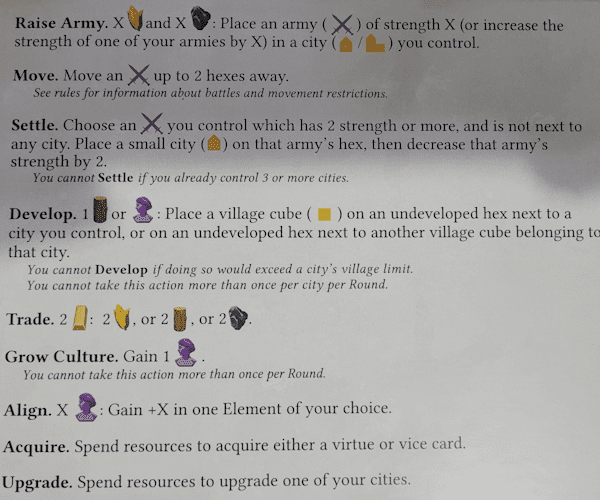
- Raise Army: Armies are represented by 6-sided dice. The strength of an army is the number the die is currently set to. If you want to build a new army or upgrade an existing one, spend 1 food and 1 ore for each point of strength being created.
- Move: The move action allows you to move an army up to two spaces. Note that some spaces have small tick-marks on one or more outside edges; if you are crossing one or more of these to get to the adjacent hex, that will cost two movement points. Some spaces have heavy squares along one or more outside edges; armies cannot move across these barriers.
- Settle: Where you have an army of at least strength 2 on a space that is not adjacent to another city, you can use this action to reduce the army’s strength and place a new small city on the board.
- Develop: By spending a resource (wood or culture), you can place a village on the board into an unsettled space adjacent to a space you have settled. Each village is associated with a city (the cities have 0, 1, 2 or 3 pips; the villages associated with a city will be places to have the same number of pips showing). Small cities can support up to two villages; large cities can support up to three.
- Trade: If you have two gold, you can trade it in to get any other resource except culture.
- Grow Culture: Taking this action gets you 1 culture.
- Acquire: This action is how you gain Vice and Virtue cards. Vice cards generally grant you some resources and a special ability; Virtue cards cost you resources and grant you an ability. At the end of the game, Vice cards all cost you a point while Virtue cards give you a point. In order to take a particular Vice or Virtue, your score along the alement track must be equal to or greater than the level of the card. Some of the Vices and Virtues are incompatible; if you take one of these and have the other… that first one has to go (this is a way to get rid of your Vices).
- Upgrade: Resources can be spent to make a small city a large city, or to upgrade a large city into a specialized city. Specialized cities provide bonuses depending upon the type of specialization they have taken on.
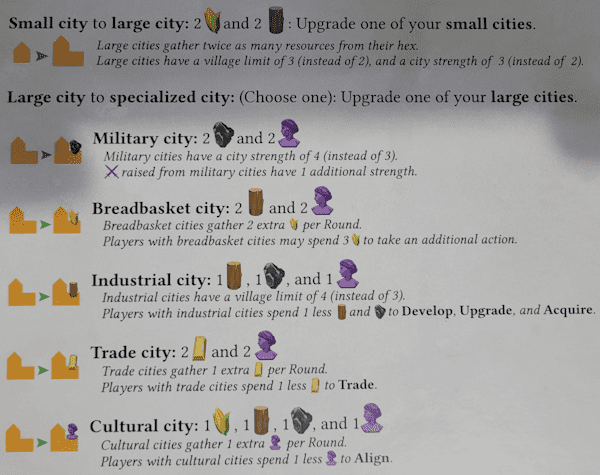
Combat in the game is rather Risk-like. Strengths of each side are tallied (+1 per army power level, +2 per small city, +3 per large city). If the strength is 3+, you get to roll 3 eight-sided dice. Otherwise, you get to roll a number of dice equal to your strength. If both sides have at least two dice in the fight, then the two highest rolls are compared; otherwise just the single highest roll is compared (ties go to the defender). Each loss on those dice removes 1 army strength from that side; if all army strength is gone, then temporary damage is done to the city. The fight continues until one side is eliminated, or the attacker retreats. If an army is in a space with an opposing village and no opposing army, the village is pillaged (yes, that is the term they use) meaning the attacker gets a resource based on the space, and the village is gone.
Over a period of eight rounds (a total of 32 actions), factions will attempt to build up, survive, and gain Virtue. If a player ever has no cities, they are eliminated. In the end, the faction that remains with at least one city on the board and has the most virtue points (equal to: Virtue cards – Vice cards) wins.
Thoughts
On paper, there is a lot to love here. The dynamic of building cities vs. working the element board should be quite cool. The impact of the event board should be exciting. In practice… not so much. There is a Catan–like feel to much of the game, with the parts about laying foundations upon which to build being removed. Dice are only used on a few occasions (they are primarily for combat), yet with the event, Vice, and Virtue cards, there is an underlying feeling that so much of what is about to happen to you is purely random.
The game is rather binary. In the rules, it states:
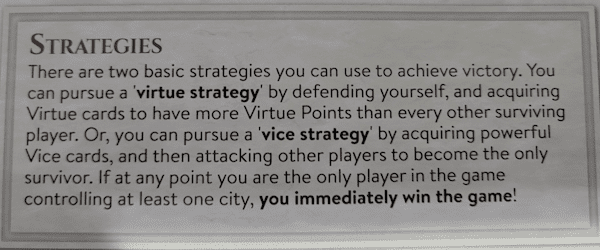
The phrase “two basic strategies” is a vast understatement. There are two strategies, period. There is no middle ground here. You either go for blood, or you turtle and hope to survive.
A couple of the factions are set up such that they are telling you which of these strategies you will use; you can attempt to go the other way, but that faction’s nature is going to fight you. In my opinion, the factions each need to have three special abilities: one designed for an offensive strategy, one designed for a defensive strategy, and one designed as a more neutral bonus or boon.
While we are talking about this, the game needs something that adds more than these two options as a viable strategy. The points are literally just the cards you have. If you survive the game, you could be reduced to a single small city and win because you had one more Virtue card than someone else. This duality (this binary state of the game), needs another dimension to make the game feel like you have some sort of option. As it is, you do not.
Combat is freaking brutal! If you are going to go on the offensive, you need to have several points of strength above that of your enemy because the die rolls favor the defender (they win ties). This may not seem like a huge deal, but it is when you consider that if both factions are rolling three dice, the defender will win both compared dice about 45% of the time (this is, by the way, why Risk limits the defender to two dice while the attacker can use up to three; winning ties is enormous otherwise). When you attack, you had better not have any enemy armies within striking range after either or those forces might just turn your gains into a Pyrrhic victory at best.
Every issue this game faces is exacerbated by the Vice and Virtue cards. Although most of these cards are not problematic, the fact that they are the one and only place where points are gathered is. Even if this were not the case, some of these cards are just wrong. Most of these cards give resources, cool boons and bonuses, and perhaps a new option. But, it seems, the designers decided to throw in the occasional curveball.
For example, the level 3 vice for Void is called Chaos. When that card came out in one game, it literally undid all of the progress made by three players over the previous four turns. As in it moved their progress backwards the equivalent of a quarter of the game, and forced them to spend the next quarter of the game trying to get back to where they were. There is half the game gone.
As one of those players said to me: “That just killed what little fun was being had.”
Imagine a game of Sorry where there existed a card that sent all but one of each other player’s pawns back to their start spaces, even if those pawns were in the home row or had already reached home. This would not be fun in the slightest. That card may as well have said, “Rocks fall. Everyone dies.”
Getting those Vice and Virtue cards is not that difficult. This is because movement along the element board axis tracks is far, far too fluid. It does not take much to reach the 3 or 4 space on a track, making you eligible for the level 3 Vice or a level 4 Virtue. Vice cards do not cost any resources; the cost for Virtue cards is a pittance. The effect of a few of these far and away outstrips their cost.
The fact that it is an odd/even split here feels wrong as well. If that track got more difficult to advance within as you reached out to the edges, that would be an improvement. But more to the point, if each value (1, 2, 3, and 4) had both a Vice and a Virtue, allowing the player a choice and granting them some more agency, this would make things far more dynamic, in my opinion. This, of course, necessitates re-examining all of those cards for their relative power and degree of fun.
Oh my, the Event board. The events of the first two ages are interesting and fun. The events of the last two ages are not. This is the poster child for everything my colleague Justin Bell hates about event decks.
And so on.
There are some things that need to be addressed in the production. Since I have a pre-production copy, I am really hoping that these are addressed (along with some of the design issues above).
- Players each get 15 village cubes. These are used as villages, but are also used to keep track of things like your element board status (3 cubes) as well as various choices made (e.g., if a Vice or Virtue card has you make a choice, you might need to track that choice with a village cube). For most factions, the 12 cubes you have in your inventory are plenty. For the green Faction, it is not. The whole schtick with that faction is being able to put out, and support, extra villages. They can easily run out of tokens.
- The use of d6s for armies is cute… but not really practical. The way armies work, using simple color-coded disks and stacking them would be easier and more practical.
- The markings indicating the rough or impassable terrain are at the very edge of the spaces. If the die used to cut these tiles is off, even by a little, it can make this very difficult to read. I feel that these markings need to be entirely inside the boundary of the tile art.
- The rulebook needs work. We tried to look up the way pillaging villages worked, and that rule is not where you would expect it and has nothing that brings attention to it. Given the number of times the phrase “pillaging a village” shows up on the cards, this rule needs to stand out more.
- The rulebook covers most basic situations. But the faction abilities create situations where the rules are silent. For example, that green faction I brought up earlier can put two villages on the same space. If those villages are taken away and become neutral (as a result of that Chaos card that caused so many problems), do these new neutral villages both remain, or is one removed from the game? No idea. We ruled they both stayed.
- And so on.
I think the best thing I can say about the game is that the inclusion of faction quick-start sheets was inspired. Each faction has a quick start sheet which walks the player through the first round (all four actions). This explains what the recommended actions are, why those actions are recommended, and gives a new player a chance to get comfortable with the turn sequence and what the actions do. Very helpful.
Final Analysis
I want to like this game (it has some very cool ideas), but I just can’t.
I played this twice by myself (once using the solo rules, once playing three separate factions), and once with my game group (four players). When we concluded that game, I asked what they thought. Our discussion went on for over an hour about how this or that aspect of the game is almost fun. I was going to ask if anyone wanted to come back in a week or two and play it again. I got a few words into that sentence before I got a chorus of NOs. One of my friends said that he had no desire to see this game ever again. The rest nodded in agreement.
I did not react to the game as negatively as they did. That said, I did not exactly have a positive reaction to it, either. The game is a combination of interesting ideas, executed in such a way as to ensure nobody is having fun at any point in the game. This left me feeling sad. I think that, if the designer spent some time adjusting this game, there is a very good game in here somewhere. But right now…I cannot find it.


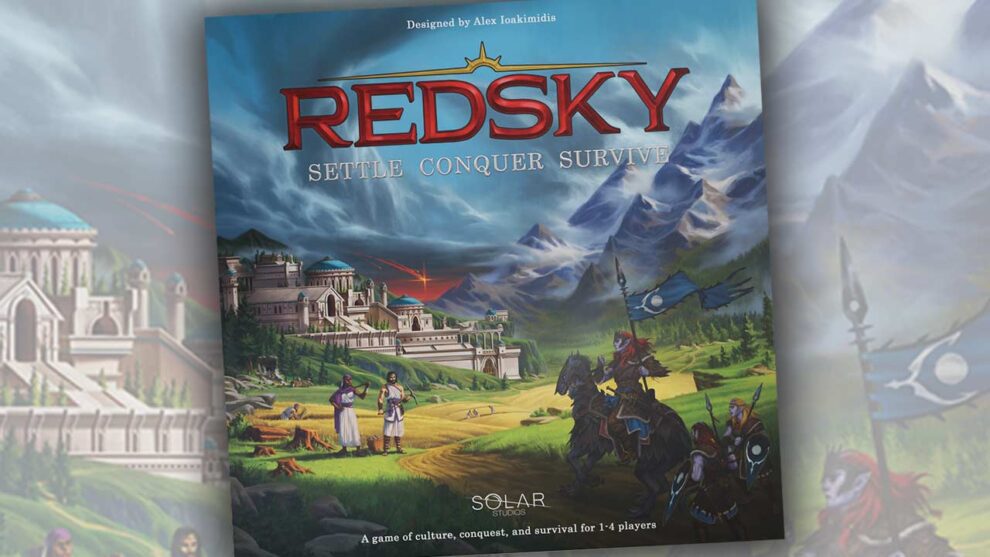








Add Comment